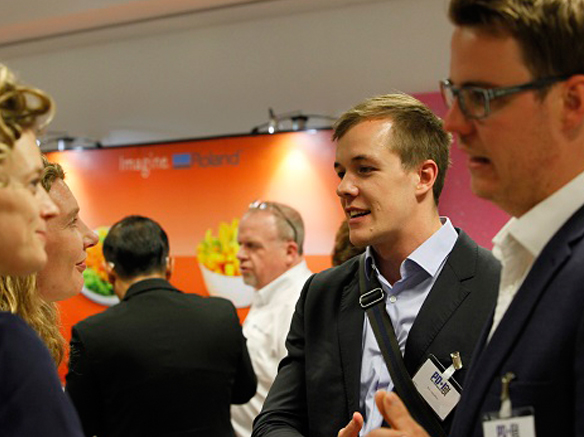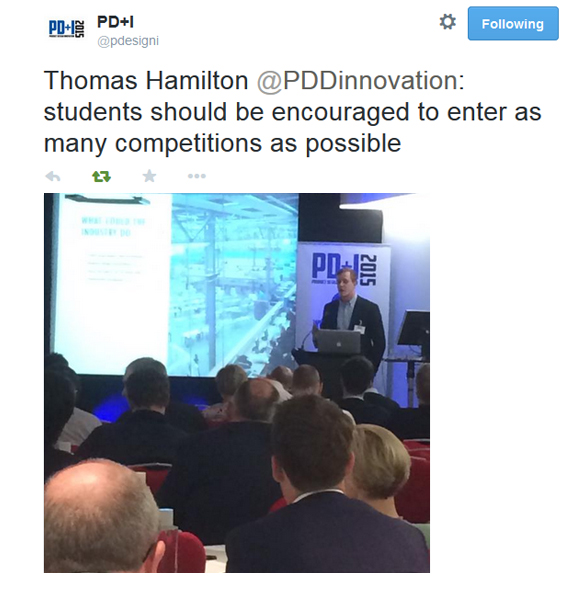Top tips on ‘Employment for Graduates’
This year the Product Design and Innovation Conference reached its fifth year. It provides a place for designers and manufacturers to meet and discuss innovation and the product design industry. This year there were talks from; Design Partners, TEAMS Design, Chauhan Studio, BAC Mono, McLaren Technology Centre, Lenovo, Bacardi Global Brands, Kinneir Dufort, Speedo Aqualab, Whipsaw Ltd. to name a few of the 33 companies that the speakers were representing.
I was also asked to speak on panel of graduates and students discussing the topic of ‘Employment for Graduates’. Speaking with me on the panel was Craig Tomkins MA Service Design student from Imperial College London who spoke on service design and Elena Dieckmann, Designer & Operations Manager at BRUISE who spoke about her product and the insight that lead to the innovation.

My background
I began my talk by discussing my background, experience and the reason I was speaking at the conference. My journey into the industry was not very orthodox as I received a placement through a student design competition which led to a full time position. But there were some tips that I could offer for students trying to get into the industry.
The second half of the talk looked at the difficulties that I encountered when applying for jobs and how prepared for the industry I was. From these difficulties and my industry experience I tried to offer a few insights to the companies that were at the conference.
Get a good work placement
One of the areas that I highlighted was for students to get a good placement. A good placement goes a long way to closing the gap in knowledge between what is taught at universities and the applicable skills for industry. It helps to develop the areas that are really needed on live briefs, such as; rapid idea generation and informed design through knowledge of materials, manufacturing techniques and design for manufacture. Not only do placements help with design related skills but also interpersonal skills, working with clients and understanding quality systems.
Enter competitions
To put this into action I encouraged companies to offer short and long term placements and to sponsor student design competitions with placements being the prize. This benefits the student in gaining the required skills, it allows the student to have a platform to impress employers and facilitates employers in discovering talent that they wouldn’t otherwise have seen. Students should be encouraged to enter as many design competitions as possible as these can increase their chances of being seen by employers which is often the hardest part of employment, it is also a great accolade to have on their CVs and sets them apart.
Get companies and universities to work together
Another area that I focussed on was for companies to have a greater input in the university syllabus. This would help to align the students’ projects with the work that is being expected by the industry. To do this I suggested the companies should open up a constant dialogue with universities. Whether that means universities getting final year product briefs from companies, getting employers to review the marking criteria or running workshops for students to run their ideas past companies. This would mean that the graduates that employers are approaching at degree shows and sending in their portfolios to have the skills that employers are after.

Be persistent
Hearing the feedback from members of the audience was great and getting a conversation started between companies and graduates was really interesting. Merle Hall (Client Services Director at Kinneir Dufort) had a very interesting point and advice for graduates looking for work; that persistence when applying for a position goes a long way and following up on your application shows you really want the job especially if you haven’t received feedback on your application for a few weeks.
Look outside the UK
The panel also helped to raise questions from industry professionals such as Dan Harden (President at Whipsaw Inc.). He asked why students from the UK weren’t applying for placements and positions in Silicon Valley, California? As he rarely receives applications from the UK despite huge opportunities becoming available over there every day, in a rapidly growing area for design and technical advances.
Key insights from PD+I 2015
There were some great insights into the work done and the methods of companies within the design industry. Some of the most valuable insights were;
Dan Hardens (President/CEO/Principal Designer at Whipsaw Inc.) rule-busting principles for design companies to innovate and flourish. Which were;
1. Find the gem of meaning – Discover that key insight.
2. Contemplate on the non-figurative ideas.
3. Think less, see more – Be inspired by non-figurative ideas.
4. Adore the medium and its method – Materials alone can carry a product.
5. Shake up the process – It fosters happy accidents.
6. Listen only to the end user – Listen, observe, be sympathetic, feel their problem.
7. Be creatively audacious – If the wind doesn’t blow the grass doesn’t stir.
8. Get out of your mind – The wider the perspective the deeper the concept, step outside your own cranial box.
9. Let content lead technology – Let your solution be an outcome of utility.
10. Get strange – Try something edgy and strange not just something you know.
Brian Stevens (Co-Founder and Managing Director at Design Partners) spoke about the ‘new’ type of client. One that is informed, that leads the design process and how companies should deal with this. The key for him was to understand client ambition, spend time to understand that ambition and see where it is leading. In doing this companies should also design for the core group but expand the market. He summarised by saying that companies should build the ambition of the client and develop it through intent.
Paola Lorini is an independent consultant and advisor in design strategy, management and communication. He spoke on the topic of designers moving from inventors to entrepreneurs.
He began by quoting Michael Marks (CEO of Flextronics) “In today’s crowded consumer markets, where low price and increased functionality is the rule, industrial design is a key competitive differentiator”. He went onto discuss how designers are becoming integral to companies that aren’t necessarily within the design industry with some making it into high positions due to their innovative thinking and problem solving abilities. He predicted that we would start seeing designers in the boardrooms and key decision making positions. He finished by listing his views on the changing traits of good designers;
1. Good designers will love the unknown.
2. Good designers will know that quality is nothing without speed.
3. Good designers will give more than they will take.
4. Good designers will speak other languages – Cultural mediators, speak the language of other stakeholders, emotional intelligence.
5. Good designers will think holistically but control even the smallest details.
6. Good designers will never forget that beauty should be at the heart of value creation – Beauty is universal.
7. Good designers need to become irreplaceable.


